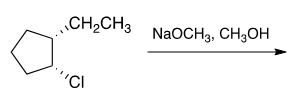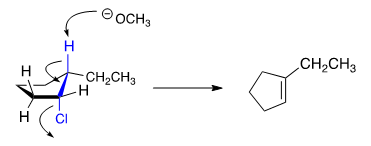Which reaction mechanism predominates in the reaction below?


Loading ...
Correct Answer: B. E2
E2 is the likely reaction to occur here:
1. Consider the leaving group: if primary, the reaction will almost certainly be SN2. If tertiary, the reaction cannot be SN2. Depending on the type of nucleophile/base, it will either proceed with concerted elimination (E2) or through carbocation formation (SN1/E1).
2. Charged nucleophiles/bases (such as –OCH3 in this example) will favor SN2/E2 pathways (i.e. eliminate SN1/E1). If a charged species is not present, the reaction is likely to be SN1/E1.
3. Polar protic solvents (like CH3OH) tend to favor elimination (E2) over substitution (SN2). Polar aprotic solvents tend to favor substitution (SN2) relative to elimination (E2).

E2 reactions occur quickest when the H-C bond and C-LG bonds involved are co-planar, or as close as possible to 180° with respect to each other. This is known as an antiperiplanar conformation. This conformation positions the sigma bonds being broken in the proper alignment to become the new pi bond.
First, determine the lowest energy chair conformation required for reaction, where the LG is axial and any other large groups remain equatorial. Once determined, two pathways must be considered. Removal of the proton that provides the more stable (tri-substituted vs. di-substituted) double bond (recall Zaitsev’s rule) is the preferred pathway.
Subscribe below to get the DAT Question of the Day delivered straight to your inbox every morning.

